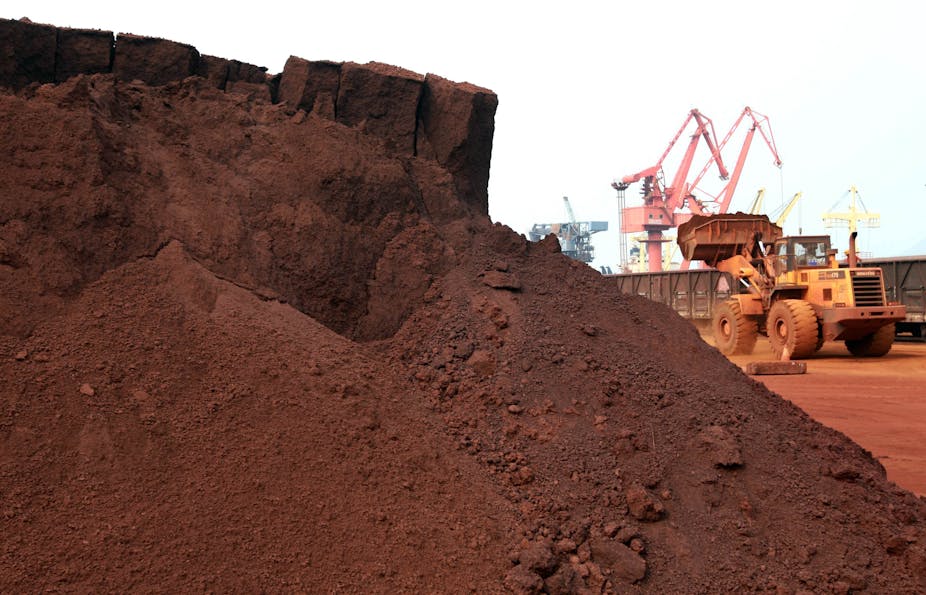News outlets recently reported a new paper in Nature Geoscience from a Japanese team documenting very large amounts of Rare Earth Elements (REE) in the mud at the bottom of the Pacific Ocean.
REE are essential for many new developments in electronics and future energy technologies, including solar voltaic cells, LED’s, electric motors, wind turbines and computers.
They include lanthanum, praseodymium, neodymium, europium, terbium and dysprosium. A single wind turbine may contain a tonne of neodymium. The electric car industry cannot take off without REE.
Currently China produces 97% of global supplies of REE, and available resources for some REEs are measured in terms of just a few decades, even at today’s rate of consumption. It is expected that demand will soon outstrip supply.
Processing of ore can require leaching with hydrochloric acid or sulfuric acid (both of which are products of the petrochemical industry), ion exchange separation, solvent partitioning and crystalisation.
By-products and contaminants can be environmentally damaging. Among these are thorium and uranium which are risks to animal health and the environment. China currently produces most of the world supply of REE because it has cheap labour and low safety requirements.
There is concern that the replacement of fossil fuel energy throughout the world could be scuppered by a shortage of REE for alternative energy infrastructure.
The new study reports that at some sites the oceanic mud hold about 25,000 tonnes REE per square kilometre of ocean floor, so theoretically a mere six square kilometres would be enough to meet current world demands for a whole year.
The total sub-oceanic REE resources could be about 100 billion tonnes, which is 1,000 times more than the known terrestrial resources. The authors from Japan point out that such mud “may constitute a highly promising resource for the future”.
So, is this discovery the saviour of the future energy industry?
A couple of things are worth noting here:
1) So called Rare Earths are not actually that rare.They are very abundant in the earth’s crust (in similar amounts to cobalt and nickel). The problem is that they are distributed at low concentrations and are difficult to refine.
2) REE in ocean sediments have been known about for decades. What is new is the more detailed analysis of the distribution, amounts and complexity of theses elements in the mud.
The concentrations of REE in mud are not particularly high compared to terrestrial deposits, but if the mud is brought to the surface it may be easier to extract than terrestrial deposits, and the mud contains much less of the damaging thorium and uranium.
So if deep oceanic mud has potential advantages, does it have disadvantages?
Yes, the mud deposits are at depths of about 5,000 meters. What will be the costs of developing technology and infrastructure to collect cubic kilometres of mud every year and transporting it to land for processing?
What will be the impacts on ocean floor life and ocean ecosystems of scraping up the mud?
Where will the waste be deposited?
The optimistic view of this “news” is that a vast resource of REE has been documented, giving hope that we have the resources for large-scale alternatives to fossil fuel energy.
The more objective view is that this report in Nature Geosciences changes little, since we have known all along that there are vast amounts of REE in the earth. If anything it highlights the fact that REE will be increasingly challenging to find, mine and refine.
Whether terrestrial or oceanic in origin, the mining of REE deposits and the processing into purified elements is fossil-fuel-dependent, potentially damaging to the environment, a health risk to workers, and expensive.
As the price of fossil fuels increases in future, so will the cost of REE and the alternative energy sources on which they depend.
So called “clean” or “green” energy is more of a “muddy green” and will be increasingly expensive to build and sustain in the long term as oil prices rise.
Humanity should be looking at ways to reduce the demand for all resources, rather than scrabbling in the ocean floor mud for resources in a vain attempt to sustain the current model of growth and consumption.
This will inevitably drive the continued consumption of fossil fuels and continued greenhouse gas emissions into the atmosphere.
Of course our industrialised societies will not willingly contemplate a deliberate slowing of growth. Mother Earth will take that decision for us.
A version of this article first appeared in Shaping Tomorrow’s World.

